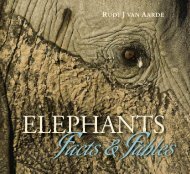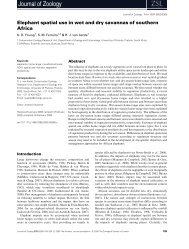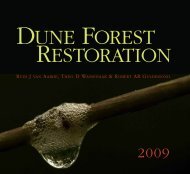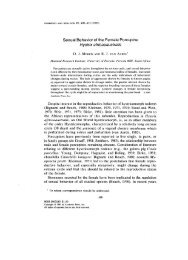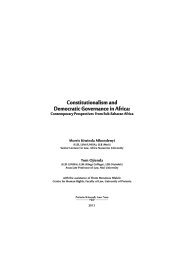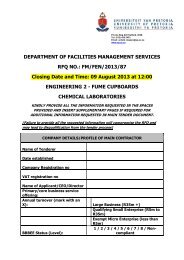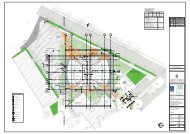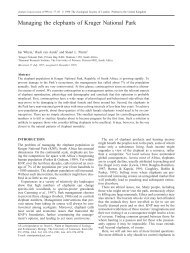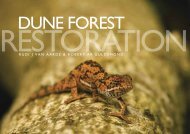A review of the successful eradication of feral cats from sub ... - CERU
A review of the successful eradication of feral cats from sub ... - CERU
A review of the successful eradication of feral cats from sub ... - CERU
Create successful ePaper yourself
Turn your PDF publications into a flip-book with our unique Google optimized e-Paper software.
A <strong>review</strong> <strong>of</strong> <strong>the</strong> <strong>successful</strong> <strong>eradication</strong><br />
<strong>of</strong> <strong>feral</strong> <strong>cats</strong> <strong>from</strong> <strong>sub</strong>-Antarctic Marion<br />
Island, Sou<strong>the</strong>rn Indian Ocean<br />
M.N. Bester 1* , J.P. Bloomer 1,† , R.J. van Aarde 1,‡ , B.H. Erasmus 1,# , P.J.J. van Rensburg 1,§ ,<br />
J.D. Skinner 1, , P.G. Howell 2 & T.W. Naude 3<br />
1 Mammal Research Institute, Department <strong>of</strong> Zoology and Entomology, University <strong>of</strong> Pretoria, Pretoria, 0002 South Africa<br />
2 Department <strong>of</strong> Infectious Diseases, Faculty <strong>of</strong> Veterinary Sciences, University <strong>of</strong> Pretoria, Onderstepoort, 0110 South Africa<br />
3 Department <strong>of</strong> Pharmacology and Toxicology, Faculty <strong>of</strong> Veterinary Sciences, University <strong>of</strong> Pretoria, Onderstepoort, 0110 South Africa<br />
Received 15 July 2001. Accepted 12 March 2002<br />
This paper <strong>review</strong>s <strong>the</strong> history <strong>of</strong> <strong>the</strong> <strong>feral</strong> cat <strong>eradication</strong> programme on <strong>sub</strong>-Antarctic<br />
Marion Island based on unpublished minutes <strong>of</strong> meetings, reports, letters, <strong>the</strong>ses and<br />
published scientific papers; and reflects on <strong>the</strong> outcome <strong>of</strong> <strong>the</strong> <strong>eradication</strong> campaign. The<br />
19-year programme comprised seven phases, commencing with a description <strong>of</strong> <strong>the</strong> effect<br />
<strong>of</strong> <strong>the</strong> <strong>cats</strong> on <strong>the</strong> Marion Island ecosystem, <strong>the</strong> characteristics <strong>of</strong> <strong>the</strong> cat population and <strong>the</strong><br />
formulation <strong>of</strong> a management policy (phase 1: 1974–1976). Methods for control were<br />
selected and preparations were made for <strong>the</strong> implementation <strong>of</strong> <strong>the</strong> primary control measure,<br />
biological control with <strong>the</strong> feline panleucopaenia virus (phase 2: 1976/77). The virus<br />
was released in 1977 (phase 3: 1977), followed by <strong>the</strong> determination <strong>of</strong> its effects (phase 4:<br />
1977–1980). Monitoring <strong>of</strong> <strong>the</strong> effects <strong>of</strong> <strong>the</strong> virus continued, and <strong>the</strong> secondary control<br />
measure <strong>of</strong> hunting at night was tested (phase 5: 1981–1983). Full-scale implementation <strong>of</strong><br />
hunting and continued monitoring <strong>of</strong> <strong>the</strong> effects <strong>of</strong> both <strong>the</strong> disease and hunting followed<br />
(phase 6: 1986–1989). The inclusion <strong>of</strong> intensive trapping and poisoning as tertiary control<br />
measures culminated in <strong>the</strong> final <strong>eradication</strong> <strong>of</strong> <strong>cats</strong> <strong>from</strong> Marion Island in 1991 (phase 7:<br />
1989–1993).<br />
Key words: <strong>feral</strong> <strong>cats</strong>, <strong>eradication</strong> campaign, overview, Marion Island.<br />
INTRODUCTION<br />
In June 1962, at <strong>the</strong> 13th Conference <strong>of</strong> <strong>the</strong> International<br />
Council for Bird Preservation, concern<br />
was voiced about <strong>the</strong> effects <strong>of</strong> man and domestic<br />
animals on <strong>the</strong> avifauna <strong>of</strong> <strong>sub</strong>-Antarctic islands.<br />
An appeal was made to governments to recommend<br />
measures to protect and conserve <strong>sub</strong>-<br />
Antarctic fauna and flora. As a result <strong>of</strong> this appeal<br />
Dr E.M. van Zinderen Bakker was asked at <strong>the</strong> first<br />
meeting <strong>of</strong> <strong>the</strong> South African Scientific Committee<br />
on Antarctic Research (SASCAR) to establish <strong>the</strong><br />
effects <strong>of</strong> <strong>feral</strong> domestic <strong>cats</strong> (Felis catus) on<strong>the</strong><br />
bird populations <strong>of</strong> Marion Island (Unpublished<br />
*To whom correspondence should be addressed.<br />
E-mail: mnbester@zoology.up.ac.za<br />
Present addresses:<br />
† Centurion Akademie, P.O. Box 10200, Centurion, 0046 South Africa.<br />
‡ Conservation Ecology Research Unit, Department <strong>of</strong> Zoology and<br />
Entomology, University <strong>of</strong> Pretoria, Pretoria, 0002 South Africa.<br />
# 7 Edgar Davis Street, Kimberley, 8301 South Africa.<br />
§ P.O. Box 234, Stella, 8650 South Africa.<br />
The Wildlife Unit, Faculty <strong>of</strong> Veterinary Sciences, University <strong>of</strong><br />
Pretoria, Onderstepoort, 0110 South Africa.<br />
SASCAR minutes, June 1963).<br />
Cats had been introduced to <strong>the</strong> island in early<br />
1949 to control <strong>feral</strong> house mice (Mus musculus)<br />
in <strong>the</strong> area <strong>of</strong> <strong>the</strong> meteorological station (van<br />
Aarde 1977). These mice were thought to have<br />
been introduced before 1818 by <strong>the</strong> earliest sealers<br />
or <strong>from</strong> shipwrecks (Watkins & Cooper 1986).<br />
In 1965 van Zinderen Bakker reported that <strong>the</strong> <strong>feral</strong><br />
cat population was not large enough to threaten<br />
bird populations, and that <strong>the</strong> <strong>cats</strong> were indeed<br />
contributing to <strong>the</strong> control <strong>of</strong> mice in <strong>the</strong> meteorological<br />
station (Unpublished SASCAR minutes,<br />
October 1965). However, ten years later, <strong>the</strong> <strong>cats</strong><br />
were considered to be detrimentally affecting bird<br />
populations, and an assessment <strong>of</strong> <strong>the</strong> impact <strong>of</strong><br />
<strong>the</strong> cat population was recommended (Condy<br />
1974). With proposals <strong>from</strong> Anderson & Condy<br />
(1974) as guidelines, SASCAR approved a project<br />
on <strong>the</strong> <strong>cats</strong>, with <strong>the</strong> aim <strong>of</strong> eradicating <strong>the</strong> population<br />
and so enabling recovery <strong>of</strong> bird populations.<br />
Marion Island (46°54’S; 37°45’E) is a volcanic<br />
<strong>sub</strong>-Antarctic island in <strong>the</strong> Sou<strong>the</strong>rn Indian Ocean.<br />
South African Journal <strong>of</strong> Wildlife Research 32(1): 65–73 (April 2002)
66 South African Journal <strong>of</strong> Wildlife Research Vol. 32, No. 1, April 2002<br />
The island has an area <strong>of</strong> 29 000 ha and comprises<br />
coastal (0–100 m a.s.l.), interior (100–500 m) and<br />
central montane regions (500–1230 m). The central<br />
mountains are covered by snow and ice fields,<br />
particularly in winter. Most <strong>cats</strong> were found below<br />
500 m, an area <strong>of</strong> approximately 19 000 ha. The<br />
island is continuously <strong>sub</strong>ject to low temperatures<br />
(annual mean 5°C), strong westerly winds (gales<br />
on 107 days per year and gusting up to 160 km/hr)<br />
and high humidity. Mean annual precipitation in<br />
<strong>the</strong> form <strong>of</strong> rain, sleet and snow is 2576 mm. The<br />
island has a tundra biota, with habitat types comprising<br />
vegetated and bare black lavas, grey lavas,<br />
volcanic cones and coastal Cotula hummocks<br />
(van Aarde 1977).<br />
The <strong>sub</strong>sequent <strong>eradication</strong> programme can be<br />
divided into seven clearly defined phases spanning<br />
19 years.<br />
PHASE 1<br />
Since an <strong>eradication</strong> programme would require<br />
detailed knowledge <strong>of</strong> <strong>the</strong> interaction between <strong>the</strong><br />
<strong>cats</strong> and <strong>the</strong>ir environment, a study on distribution,<br />
density, habitat selection, feeding and reproduction<br />
in <strong>the</strong> cat population was carried out <strong>from</strong><br />
December 1974 to April 1976 (van Aarde 1977,<br />
1978, 1979, 1980, 1983, 1984). Originating <strong>from</strong><br />
two groups <strong>of</strong> two and three <strong>cats</strong> respectively, <strong>the</strong><br />
1975 population was estimated to be 2139 ± 290<br />
individuals, increasing at a rate <strong>of</strong> 26% per annum<br />
(van Aarde 1979). The population <strong>the</strong>n consumed<br />
an estimated 450 000 burrowing petrels annually<br />
and posed a serious threat to <strong>the</strong> burrowing<br />
avifauna <strong>of</strong> <strong>the</strong> island (van Aarde 1980), with <strong>the</strong><br />
common diving petrel (Pelecanoides urinatrix)<br />
apparently having been driven to local extinction<br />
as early as 1965 (van Aarde 1980; Watkins &<br />
Cooper 1986).<br />
While this investigation was in progress, plans<br />
were already being formulated to eradicate <strong>the</strong><br />
<strong>cats</strong>. At an ad hoc discussion in June 1976 it was<br />
recognized that a multi-faceted approach would<br />
be necessary for <strong>the</strong>ir <strong>eradication</strong>. Two methods<br />
were considered most likely to succeed, namely<br />
biological control and poisoning. However, as<br />
Marion Island was at <strong>the</strong> time considered to not<br />
lend itself structurally to an effective but lengthy<br />
hunting or poisoning campaign, biological control<br />
with its immediate impact was deemed most<br />
feasible. Therefore, <strong>the</strong> Department <strong>of</strong> Infectious<br />
Diseases in <strong>the</strong> Faculty <strong>of</strong> Veterinary Sciences,<br />
University <strong>of</strong> Pretoria, was approached to prepare<br />
a report as to what a biological control programme<br />
would entail. At a second ad hoc meeting in<br />
July 1976 a <strong>sub</strong>-committee <strong>of</strong> SASCAR was<br />
appointed to advise on biological control <strong>of</strong> <strong>the</strong> cat<br />
population.<br />
PHASE 2<br />
By March 1976 research on <strong>the</strong> feasibility <strong>of</strong><br />
biological control was well under way and a proposal<br />
for a biological control programme using<br />
feline panleucopaenia virus was presented to <strong>the</strong><br />
ad hoc Task Group on Extermination <strong>of</strong> Cats and<br />
Mice on Marion Island (Howell 1976). Through<br />
serological testing on a small sample collected in<br />
1975, it was demonstrated that <strong>the</strong> cat population<br />
was fully susceptible to feline panleucopaenia<br />
virus (van Aarde 1977; Erasmus 1979; Howell<br />
1984). The virus was deemed <strong>the</strong> most appropriate<br />
disease at <strong>the</strong> high cat densities present at that<br />
time, and it was decided that its introduction<br />
should be implemented. The feline panleucopaenia<br />
virus is host-specific, highly infectious,<br />
results in high mortality, is highly resistant to environmental<br />
factors and occurs worldwide (van<br />
Aarde & Skinner 1981). From July 1975, <strong>cats</strong>,<br />
which up to this point had been live trapped and<br />
<strong>the</strong>n killed to obtain samples and measurements,<br />
were held captive in custom-made cages on <strong>the</strong><br />
island to serve as future carriers for <strong>the</strong> establishment<br />
<strong>of</strong> <strong>the</strong> disease. This trapping was done<br />
throughout 1976 to March 1977 (Erasmus 1979). It<br />
was recommended that a justification for biological<br />
control using <strong>the</strong> virus be prepared for SASCAR to<br />
consider, and in July 1976 <strong>the</strong> final decision was<br />
taken to release <strong>the</strong> virus. However, because it<br />
had been recognized that <strong>the</strong> virus would not<br />
remove all <strong>of</strong> <strong>the</strong> <strong>cats</strong> and that an integrated<br />
control programme incorporating various methods<br />
would be necessary, <strong>the</strong> ad hoc Task Group on <strong>the</strong><br />
Use <strong>of</strong> Poisons and O<strong>the</strong>r Methods for <strong>the</strong> Control<br />
<strong>of</strong> Cats and Mice on Marion Island was already<br />
considering additional methods, some <strong>of</strong><br />
which were to be tested for <strong>the</strong>ir feasibility for use<br />
on <strong>the</strong> island, while o<strong>the</strong>rs were rejected as<br />
unsuitable.<br />
PHASE 3<br />
The feline panleucopaenia virus was introduced<br />
as a primary control measure in March 1977 when<br />
<strong>the</strong> cat population was estimated to be 3405 (van<br />
Aarde 1979). Ninety-six captive <strong>cats</strong> were each<br />
inoculated with 1000 TCLD 50<br />
<strong>of</strong> <strong>the</strong> first passage <strong>of</strong><br />
an isolated street virus, prepared in feline kidney<br />
monolayers. The carriers were released over a
Bester et al. Review <strong>of</strong> <strong>eradication</strong> <strong>of</strong> <strong>feral</strong> <strong>cats</strong> <strong>from</strong> Marion island 67<br />
period <strong>of</strong> three days at 93 locations around <strong>the</strong><br />
island using dedicated helicopter support (Erasmus<br />
1979; van Aarde & Skinner 1981; Howell<br />
1984).<br />
PHASE 4<br />
From November 1976 to May 1978 research was<br />
undertaken to establish <strong>the</strong> effect <strong>of</strong> <strong>the</strong> release <strong>of</strong><br />
<strong>the</strong> disease on <strong>the</strong> cat population. This revealed<br />
an estimated 53.6% reduction in population size<br />
after 18 months (Erasmus 1979).<br />
O<strong>the</strong>r control measures were also evaluated for<br />
possible incorporation into <strong>the</strong> programme.<br />
Trapping had previously been tested; cage traps<br />
(Condy, Anderson, Heijnen & Smit 1975) had been<br />
used between December 1974 and April 1976 to<br />
collect samples (van Aarde 1975a,b, 1976), and<br />
between April 1976 and March 1977 to catch<br />
carrier <strong>cats</strong>, but were ineffective (Bester 1976;<br />
Erasmus 1979). In fact, cage trapping was so<br />
un<strong>successful</strong> that <strong>the</strong> carrier <strong>cats</strong> were eventually<br />
all caught by hand. Cage traps were again tested<br />
in November 1977 and April 1978, but were still<br />
ineffective with a low success rate <strong>of</strong> 702 hours per<br />
cat. Gin traps were also tested in 1978 but <strong>the</strong>se<br />
proved equally ineffective. Two <strong>cats</strong> were caught<br />
in 31 trap-days (372 h per cat), a return considered<br />
unacceptable (Keith 1978; Scholtz 1978).<br />
Cats are primarily predators and not scavengers,<br />
thus <strong>the</strong> main reason suggested for <strong>the</strong> low<br />
trapping success was <strong>the</strong> lack <strong>of</strong> a <strong>successful</strong><br />
attractant bait (Erasmus 1979). Twenty different<br />
attractant baits were tested on <strong>the</strong> island, including<br />
baits used for caracal (Felis caracal) in South<br />
Africa (van Aarde 1975b), and o<strong>the</strong>rs that had<br />
been specially formulated (van Aarde 1975b;<br />
Bester 1976; Keith 1978; Scholtz 1978). Limited<br />
success was obtained with natural prey <strong>of</strong> <strong>cats</strong> as<br />
well as raw liver. Catnip oil and jackrabbit distress<br />
calls were un<strong>successful</strong> as attractants (Erasmus<br />
1979). Coyote-getters were un<strong>successful</strong> owing to<br />
lack <strong>of</strong> suitable attractant bait (Keith 1978; Scholtz<br />
1978).<br />
The use <strong>of</strong> poison also proved un<strong>successful</strong> as a<br />
control agent. Sodium mon<strong>of</strong>luoroacetate (compound<br />
1080) was considered to be <strong>the</strong> most suitable<br />
poison as it posed little threat <strong>of</strong> pollution and,<br />
according to <strong>the</strong> available literature, birds had a<br />
higher tolerance than mammals. Toxicity trials<br />
were carried out on <strong>the</strong> island on likely non-target<br />
birds, but it was found that <strong>the</strong>se all had similar<br />
lethal doses to <strong>cats</strong>, and it was recommended that<br />
experiments with 1080 be abandoned (Erasmus<br />
1979). The massive campaign that would be necessary<br />
to lay poison baits, and <strong>the</strong> lack <strong>of</strong> suitable<br />
bait, also made poisoning impractical. However, it<br />
could perhaps be used under very specific circumstances<br />
(Keith 1978; Scholtz 1978; Erasmus<br />
1979), such as to target particular <strong>cats</strong> while taking<br />
care to prevent non-target species <strong>from</strong> taking <strong>the</strong><br />
bait.<br />
Poison gas was considered unsuitable, due to<br />
<strong>the</strong> honeycomb nature <strong>of</strong> <strong>the</strong> terrain with innumerable<br />
crevices and burrows as well as <strong>the</strong> danger to<br />
burrowing birds. A sticky <strong>sub</strong>stance containing<br />
poison, applied to burrow entrances and ingested<br />
by <strong>cats</strong> while grooming, was considered too timeconsuming,<br />
costly and impractical owing to <strong>the</strong><br />
number <strong>of</strong> burrows that would need to be treated.<br />
Unless 1080 was used, <strong>the</strong> possibility <strong>of</strong> poison<br />
leaching into <strong>the</strong> environment, with unknown consequences,<br />
was also considered unacceptable.<br />
Cadmium and lithium in bait were considered as<br />
sterilizing agents. However, at <strong>the</strong> 4th meeting <strong>of</strong><br />
<strong>the</strong> Work Group for <strong>the</strong> Monitoring <strong>of</strong> Sea Pollution<br />
in July 1975 it had been strongly recommended<br />
that Marion Island not be disturbed in any way, so<br />
as to provide a reference point for monitoring<br />
pollution. Suitable control measures <strong>the</strong>refore had<br />
to be found with this recommendation in mind and<br />
<strong>the</strong> method was rejected. The lack <strong>of</strong> suitable bait<br />
would also make this method impractical (Unpublished<br />
SASCAR minutes, March 1976).<br />
Because trapping had proved un<strong>successful</strong>,<br />
both van Aarde (1977) and Erasmus (1979) had<br />
resorted to shooting to collect <strong>cats</strong>. Both used<br />
.410-gauge shotguns, hunting during <strong>the</strong> day,<br />
which removed a total <strong>of</strong> 190 <strong>cats</strong> at 2.64 hours per<br />
cat. They concluded that using only two hunters<br />
would not significantly reduce <strong>the</strong> population.<br />
Keith (1978) tested hunting using a .22 calibre rifle,<br />
both during <strong>the</strong> day and at night. He concluded<br />
that night hunting would be no more effective than<br />
day hunting because <strong>the</strong> headlamps did not ‘hold’<br />
<strong>cats</strong> (i.e. spotlights were not used) and that hunting<br />
at night was too dangerous. Shotguns were,<br />
however, more effective than rifles.<br />
The use <strong>of</strong> dogs to hunt <strong>cats</strong> was at first thought<br />
to be inappropriate due to <strong>the</strong> nature <strong>of</strong> <strong>the</strong> terrain<br />
and <strong>the</strong> possible impact <strong>of</strong> <strong>the</strong> dogs on birds. However,<br />
it was <strong>sub</strong>sequently decided to test three<br />
Jack Russell terriers on <strong>the</strong> island. This resulted in<br />
three <strong>cats</strong> being killed at a rate <strong>of</strong> 6.67 hours per<br />
cat and this method was dismissed. However, <strong>the</strong><br />
dogs had been trained in <strong>the</strong> hunting <strong>of</strong> rock hyrax<br />
(Procavia capensis), not <strong>cats</strong>, and were used on
68 South African Journal <strong>of</strong> Wildlife Research Vol. 32, No. 1, April 2002<br />
only six days for a total <strong>of</strong> 20 hours <strong>of</strong> hunting<br />
(Linger 1978). Dogs were again tested on <strong>the</strong><br />
island in August 1989. One German shepherd and<br />
one Labrador were used for three days <strong>of</strong> hunting,<br />
and although un<strong>successful</strong> it was concluded that<br />
dogs would be a useful method for use in conjunction<br />
with any o<strong>the</strong>r methods (Bekker 1989). Bekker<br />
(1989) pointed out, however, that dogs would<br />
need to be specifically trained to hunt <strong>cats</strong> and that<br />
considerable logistical support for <strong>the</strong> dogs would<br />
be essential.<br />
It must be emphasized, however, that much <strong>of</strong><br />
<strong>the</strong> above-mentioned testing (o<strong>the</strong>r than trapping<br />
and hunting) was carried out over 6–24 days and<br />
was probably inadequate.<br />
In February 1978 some doubt was expressed<br />
that <strong>the</strong> <strong>cats</strong> could ever be eradicated, but that<br />
<strong>the</strong>y could be fur<strong>the</strong>r controlled by a combination<br />
<strong>of</strong> mechanical methods (Unpublished SASCAR<br />
minutes, August 1978). Hunting was proposed as<br />
<strong>the</strong> method <strong>of</strong> choice, to be implemented as soon<br />
as possible. This would require a large hunting<br />
team, working for long periods, applying a great<br />
deal <strong>of</strong> effort, so as to remove as many animals as<br />
quickly as possible. Shotguns were considered<br />
<strong>the</strong> most effective weapons and hunting teams<br />
should use <strong>the</strong>se (van Aarde & Erasmus 1978). It<br />
was also recognized that hunting, as with biological<br />
control, would only be partially effective, after<br />
which it would be necessary to incorporate still<br />
fur<strong>the</strong>r methods.<br />
In 1980, three years after <strong>the</strong> release <strong>of</strong> <strong>the</strong> virus,<br />
<strong>the</strong> newly-formed ad hoc Specialist Evaluation<br />
Group on Marion Island Cats recommended that<br />
fur<strong>the</strong>r control, monitoring and research were<br />
essential (Unpublished SASCAR minutes, 1980).<br />
PHASE 5<br />
A third study was undertaken between April 1981<br />
and May 1983 to determine what effect feline<br />
panleucopaenia virus had had on <strong>the</strong> cat population,<br />
social structure and space use by <strong>the</strong> remaining<br />
<strong>cats</strong>, <strong>the</strong>ir effect on bird populations and <strong>the</strong><br />
cost-effectiveness <strong>of</strong> hunting as a secondary<br />
control measure (van Rensburg 1985; 1986a,b;<br />
van Rensburg, Skinner & van Aarde 1987; van<br />
Rensburg & Bester 1988a,b). It was concluded<br />
that <strong>the</strong> release <strong>of</strong> <strong>the</strong> virus had resulted in an<br />
epidemic with cat numbers decreasing by 26%<br />
annually to an estimated 615 ± 107 <strong>cats</strong> in 1982<br />
(18% <strong>of</strong> <strong>the</strong> 1977 population). It was clear that <strong>the</strong><br />
virus was responsible for <strong>the</strong> population decline.<br />
Postweaning litter size had decreased and age<br />
structures had changed between 1975 and 1982<br />
owing to a decrease in <strong>sub</strong>adult numbers, as <strong>sub</strong>adults<br />
less than one year old were <strong>sub</strong>ject to<br />
highest mortality <strong>from</strong> feline panleucopaenia. The<br />
disease had spread <strong>successful</strong>ly throughout <strong>the</strong><br />
population as indicated by serum samples<br />
collected around <strong>the</strong> island. As <strong>the</strong> remaining <strong>cats</strong><br />
apparently developed immunity to <strong>the</strong> disease,<br />
indicated by a shift <strong>from</strong> moderate to low antibody<br />
titres in sampled <strong>cats</strong>, <strong>the</strong> population began to<br />
stabilize. The decline in cat numbers <strong>of</strong> 26% per<br />
year over five years <strong>from</strong> 1977 to 1982 had stabilized<br />
to a non-significant decline <strong>of</strong> 8% between<br />
1982 and 1983 (van Rensburg et al. 1987).<br />
In <strong>the</strong> 18 months after <strong>the</strong> virus was released it<br />
was estimated that <strong>the</strong> cat population had decreased<br />
by 53.6%, but despite this <strong>the</strong> bird populations<br />
were still being severely affected (Schramm<br />
1986; van Rensburg 1986b). Greatwinged petrels<br />
(Pterodroma macroptera), being <strong>the</strong> more abundant<br />
<strong>of</strong> only two winter-breeding petrels, were<br />
proving particularly vulnerable. Schramm (1983)<br />
reported zero breeding success in 1979 and 1980,<br />
while breeding success two years later was 53.5%<br />
inside cat-free exclosures as opposed to 8% outside<br />
(van Rensburg & Bester 1988a). Whitechinned<br />
petrels (P. aequinoctialis) and Salvin’s<br />
prions (P. vittata) also bred more <strong>successful</strong>ly in<br />
cat-free exclosures, but van Rensburg & Bester<br />
(1988a) estimated that 76 000 prions still fell prey<br />
to <strong>cats</strong> in 1982. Kerguelen petrels (P. brevirostris)<br />
had disappeared <strong>from</strong> a specific study area by<br />
1975 and had not reappeared (van Rensburg<br />
1985; Newton & Fugler 1989). Therefore, despite<br />
much reduced cat predation, burrowing petrel<br />
populations were still threatened, but breeding<br />
success in <strong>the</strong> cat-free areas suggested that <strong>eradication</strong><br />
<strong>of</strong> <strong>the</strong> <strong>cats</strong> could allow for recovery <strong>of</strong> bird<br />
populations.<br />
At <strong>the</strong>se reduced cat densities, hunting at night<br />
as a secondary control measure became feasible.<br />
In a specific area, sightings per hour, an index <strong>of</strong><br />
density, had decreased linearly over a short period<br />
<strong>of</strong> intensive night hunting (van Rensburg & Bester<br />
1988b), and as a result <strong>of</strong> <strong>the</strong>se trials a full-scale<br />
hunting effort was initiated in <strong>the</strong> austral spring <strong>of</strong><br />
1986. As hunting was practicable throughout <strong>the</strong><br />
island (van Rensburg 1986a), an intensive<br />
constant hunting effort was directed at controlling<br />
and possibly eradicating <strong>the</strong> remaining <strong>cats</strong> (van<br />
Rensburg & Bester 1988b). The delay <strong>of</strong> three<br />
years between <strong>the</strong> decision that hunting was<br />
indeed feasible and <strong>the</strong> start <strong>of</strong> <strong>the</strong> hunting
Bester et al.: Eradication <strong>of</strong> <strong>feral</strong> <strong>cats</strong> <strong>from</strong> Marion island 69<br />
Table 1. Night hunting, trapping and poisoning effort and returns on Marion Island <strong>from</strong> 1986 to 1993.<br />
Season 1 Hours hunted Cats seen 2 Cats shot Cats trapped No. traps No. baits Total <strong>cats</strong> killed 3<br />
86/87 2 768 1 395 393 – – – 458<br />
87/88 2 999 786 174 – – – 206<br />
88/89 3 437 603 124 2 5 – 143<br />
89/90 2 641 310 66 78 144 – 145<br />
90/91 1 378 61 11 109 410 – 120<br />
91/92 1 003 0 0 8 1 279 12 000 8<br />
92/93 131 0 0 0 1 387 18 000 0<br />
Total 14 357 3 155 768 197 1 080<br />
1 1986/87 to 1989/90 data <strong>from</strong> Bloomer & Bester (1992), 1990/91 to 1993/94 data <strong>from</strong> Bester et al. (2000).<br />
2 Includes resightings <strong>of</strong> some individuals.<br />
3 Includes <strong>cats</strong> shot during <strong>the</strong> day.<br />
programme was due to <strong>the</strong> time taken for final<br />
reports to be processed and evaluated, proposals<br />
to be made and funding to be obtained.<br />
PHASE 6<br />
Initially scheduled to run over three extended summer<br />
seasons between August 1986 and May<br />
1989, eight two-man teams using battery operated<br />
spotlights and 12-guage shotguns killed 458, 206<br />
and 143 <strong>cats</strong>, respectively (Table 1). By <strong>the</strong> end <strong>of</strong><br />
<strong>the</strong> third season progressive declines in hunting<br />
success and sighting rate <strong>of</strong> <strong>cats</strong> (Bloomer &<br />
Bester 1991) suggested that hunting alone was no<br />
longer reducing <strong>the</strong>ir numbers sufficiently.<br />
Although extremely effective, it was soon apparent<br />
that <strong>the</strong> aim <strong>of</strong> eliminating all <strong>the</strong> <strong>cats</strong> by <strong>the</strong> end <strong>of</strong><br />
<strong>the</strong> three-year hunting programme would not be<br />
realized (Bloomer & Bester 1992). An extension to<br />
<strong>the</strong> programme was requested, with a view to also<br />
reassess methods that had been un<strong>successful</strong>,<br />
inappropriate or impractical when <strong>the</strong> cat population<br />
was large, and to have hunting teams remain<br />
on <strong>the</strong> island during <strong>the</strong> winter <strong>of</strong> 1989 (Bester<br />
1988, 1989). At <strong>the</strong> same time, in 1988 <strong>the</strong> Department<br />
<strong>of</strong> Environment Affairs solicited an independent<br />
evaluation <strong>of</strong> <strong>the</strong> <strong>eradication</strong> programme by<br />
<strong>the</strong> South African National Parks Board. Randall &<br />
De Vos (1989) concluded that <strong>the</strong>re was indeed a<br />
need to eliminate <strong>the</strong> <strong>cats</strong>, that <strong>the</strong> chances <strong>of</strong><br />
<strong>eradication</strong> were good, that continued sporadic<br />
control would be an unsatisfactory <strong>sub</strong>stitute for<br />
<strong>eradication</strong>, but that hunting was indeed dangerous<br />
and that <strong>the</strong> programme did also have some<br />
negative environmental impact. They also recommended<br />
that <strong>the</strong> programme be continued. They<br />
supported hunting during winter, that dogs and<br />
baits again be tested and that controlled gin trapping<br />
and poisoning be used. These methods had<br />
previously been tested, albeit inadequately, when<br />
cat density was high and would possibly prove<br />
more appropriate at <strong>the</strong> low cat density resulting<br />
<strong>from</strong> <strong>the</strong> hunting campaign.<br />
The drastic decrease in density <strong>of</strong> <strong>cats</strong> led to a<br />
decline in pregnancy rates and in fecundity <strong>from</strong><br />
1.49 to 0.89 female <strong>of</strong>fspring per female, possibly<br />
as a consequence <strong>of</strong> lower encounter rates<br />
between males and females (Bloomer & Bester<br />
1991), which may have increased <strong>the</strong> likelihood <strong>of</strong><br />
eradicating <strong>the</strong> cat population at low densities<br />
(Bloomer & Bester 1992). A return to pre-disease<br />
litter sizes also suggested that <strong>the</strong> disease was no<br />
longer effective. At a meeting called by <strong>the</strong> Department<br />
<strong>of</strong> Environment Affairs in June 1988, <strong>the</strong> cat<br />
programme was <strong>review</strong>ed, and a task team<br />
appointed to evaluate and make recommendations<br />
on <strong>the</strong> cat programme on an ongoing basis<br />
with a view to exterminating <strong>the</strong> <strong>cats</strong> as soon as<br />
possible.<br />
PHASE 7<br />
Since increased hunting effort was financially and<br />
logistically impossible, a combination <strong>of</strong> hunting<br />
and trapping was expected to fur<strong>the</strong>r reduce <strong>the</strong><br />
population (Bloomer & Bester 1992). Experimental<br />
trapping in <strong>the</strong> winter <strong>of</strong> 1989 by four two-man<br />
teams with 48 traps, and <strong>the</strong>n with increasing numbers<br />
<strong>of</strong> traps over <strong>the</strong> following two years (96 traps<br />
in 1989/90, 410 traps in 1990/91) by five two-man<br />
teams, proved a more effective technique than<br />
hunting alone, accounting for 54% and 91% <strong>of</strong> all<br />
<strong>cats</strong> removed in <strong>the</strong> respective seasons (Table 1;<br />
Bester & Skinner 1991; Bloomer & Bester 1992).<br />
During <strong>the</strong> final year <strong>of</strong> <strong>the</strong> <strong>eradication</strong> campaign,<br />
which ended in March 1993, up to 1387 gin traps<br />
were deployed (Bester, Bloomer, Bartlett, Muller,<br />
Van Rooyen & Büchner 2000). The use <strong>of</strong> lures
70 South African Journal <strong>of</strong> Wildlife Research Vol. 32, No. 1, April 2002<br />
Table 2. Non-target species caught in gin traps <strong>from</strong> 1990 to 1993 on Marion Island.<br />
Species 90/91 91/92 92/93 Total Est. island<br />
population 1<br />
Salvin’s prion, Pachyptila salvini 37 64 85 149 >100 000<br />
Subantarctic skua, Catharacta antarctica 23 21 48 92 1 800<br />
Lesser sheathbill, Chionis minor 31 13 34 78 1 960<br />
Rockhopper penguin, Eudyptes chrysocome 1 8 10 19 137 600<br />
White-chinned petrel, Procellaria aequinoctialis 3 3 6 12 10 000<br />
Blue petrel, Halobaena caerulea 0 0 3 3 >10 000<br />
Great-winged petrel, Procellaria macroptera 0 1 0 1 >10 000<br />
Giant petrel, Macronectes spp. 0 0 1 1 3 200<br />
Grey-headed albatross, Diomedea chrysostoma 1 0 0 1 5 000<br />
Sooty albatross, Phoebetria fusca 0 0 1 1 2 000<br />
1 From Anon. (1996).<br />
(Rocky Mountain Wildlife Products, La Porte,<br />
U.S.A.) to bait traps suggested that at least some<br />
worked well at attracting <strong>cats</strong>. Inevitably, birds<br />
such as <strong>sub</strong>antarctic skuas (Catharacta antarctica)<br />
and lesser sheathbills (Chionis minor) were<br />
also trapped (Table 2), although care in setting<br />
traps kept incidental trapping to a minimum<br />
(Bloomer & Bester 1992).<br />
In conjunction with increased trapping, a largescale<br />
poisoning campaign, using sodium<br />
mon<strong>of</strong>luoroacetate injected into <strong>the</strong> carcasses <strong>of</strong><br />
12 000 day-old chickens, commenced in May<br />
1991 and was continued throughout <strong>the</strong> following<br />
winter and early spring. Poisoning was repeated<br />
over a similar period in 1992 (Bester et al. 2000)<br />
with 18 000 chicks. The exercise was governed by<br />
a very strict and detailed protocol for <strong>the</strong> use <strong>of</strong> <strong>the</strong><br />
poison, documented by Bester & Naude (1991)<br />
and amended following van Rensburg (1991), to<br />
safeguard personnel and minimize detrimental<br />
effects on <strong>the</strong> biota and <strong>the</strong> environment.<br />
The last <strong>cats</strong> were trapped by July 1991, and no<br />
fur<strong>the</strong>r signs <strong>of</strong> <strong>cats</strong> were seen despite <strong>the</strong> continued<br />
efforts <strong>of</strong> two successive teams <strong>of</strong> ten and six<br />
hunters/trappers respectively in <strong>the</strong> following 20<br />
months (1991–1993), (Table 1; Bester et al. 2000).<br />
The number <strong>of</strong> non-target species caught in<br />
traps increased <strong>sub</strong>stantially, in particular <strong>the</strong><br />
number <strong>of</strong> <strong>sub</strong>antarctic skuas (Table 2; Bester et<br />
al. 2000). However, breeding success <strong>of</strong> greatwinged<br />
petrels had improved <strong>from</strong> 0% in 1979<br />
to 59.6% in 1990, and was up to 64.2% in 1991<br />
(Cooper & Fourie 1991; Cooper, Marais, Bloomer<br />
& Bester 1995). Blue petrels had a breeding<br />
success <strong>of</strong> 64% in 1991/92, as opposed to 23.5%<br />
in 1982/83 (Fugler, Hunter, Newton & Steele<br />
1987). Whitechinned petrel breeding success was<br />
lower in 1991/92 than in 1980/81 (21.8% as opposed<br />
to 36.2%; Cooper et al. 1995). But this was<br />
within <strong>the</strong> range <strong>of</strong> success for this species at<br />
cat-free South Georgia (Hall 1987). The improved<br />
breeding success <strong>of</strong> burrowing petrels after <strong>the</strong><br />
<strong>eradication</strong> <strong>of</strong> <strong>cats</strong> suggested that <strong>the</strong> recovery <strong>of</strong><br />
affected bird populations would ensue. No <strong>cats</strong>, or<br />
signs <strong>of</strong> <strong>cats</strong>, have been seen on Marion Island<br />
during <strong>the</strong> nine years since <strong>the</strong> last <strong>cats</strong> were<br />
trapped in July 1991 (Bester et al. 2000), and it is<br />
beyond doubt that <strong>feral</strong> <strong>cats</strong> have finally been<br />
eradicated <strong>from</strong> Marion Island.<br />
CONCLUSIONS<br />
Very little effort has been expended on <strong>the</strong> control<br />
and/or <strong>eradication</strong> <strong>of</strong> <strong>cats</strong> on <strong>sub</strong>-Antarctic<br />
islands, and attempts to eradicate <strong>cats</strong> <strong>from</strong> o<strong>the</strong>r<br />
islands have met with varied success. The few<br />
such programmes that have succeeded have all<br />
been on small continental islands with small cat<br />
populations and more hospitable conditions,<br />
including Herekopare Island (28 ha, 33 <strong>cats</strong>), Little<br />
Barrier Island (2817 ha, 151 <strong>cats</strong>, Fitzgerald &<br />
Veitch 1985; Veitch 1985) and Jarvis Island<br />
(400 ha, 120 <strong>cats</strong>, Rauzon 1985). On <strong>sub</strong>-Antarctic<br />
Macquarie Island (12 000 ha) <strong>cats</strong> were not<br />
eradicated after ten years <strong>of</strong> intermittent control<br />
(Bro<strong>the</strong>rs & Copson 1988).<br />
The <strong>eradication</strong> campaign on Marion Island has<br />
been <strong>the</strong> largest and only <strong>successful</strong> one <strong>of</strong> its<br />
kind. With <strong>the</strong> benefit <strong>of</strong> hindsight, <strong>the</strong> campaign<br />
could arguably have been carried out more<br />
efficiently over a shorter period <strong>of</strong> time. Veitch<br />
(1985) suggested that <strong>the</strong> <strong>eradication</strong> <strong>of</strong> <strong>cats</strong> can<br />
only be achieved by <strong>the</strong> combined and persistent<br />
use <strong>of</strong> several methods. In order to make <strong>the</strong> operation<br />
as economical as possible, a quick initial
Bester et al.: Eradication <strong>of</strong> <strong>feral</strong> <strong>cats</strong> <strong>from</strong> Marion island 71<br />
reduction is required, followed by a large and<br />
persistent effort, using a combination <strong>of</strong> methods<br />
to remove <strong>the</strong> remaining animals. However, on<br />
Marion Island, <strong>the</strong> desire to consult widely and to<br />
fully evaluate <strong>the</strong> possible effects <strong>of</strong> each method<br />
on <strong>the</strong> native fauna and flora resulted in a cautious<br />
approach. The considerable expense <strong>of</strong> mounting<br />
each phase also made several long interruptions<br />
to <strong>the</strong> programme unavoidable.<br />
Several factors are considered to have been critical<br />
to <strong>the</strong> success <strong>of</strong> <strong>the</strong> programme on Marion<br />
Island. Perhaps <strong>the</strong> most important <strong>of</strong> <strong>the</strong>se were<br />
<strong>the</strong> susceptibility <strong>of</strong> <strong>the</strong> population to feline<br />
panleucopaenia virus. The lack <strong>of</strong> high stands <strong>of</strong><br />
vegetation, which would have rendered <strong>the</strong> hunting<br />
campaign impossible due to decreased sighting<br />
rates and hunting success. The recolonization<br />
<strong>of</strong> preferred habitats, cleared <strong>of</strong> <strong>cats</strong>, <strong>from</strong> neighbouring<br />
<strong>sub</strong>optimal areas served to continually<br />
concentrate surviving <strong>cats</strong> in smaller areas.<br />
O<strong>the</strong>r factors contributing to <strong>the</strong> success <strong>of</strong> <strong>the</strong><br />
programme were: <strong>the</strong> initial study to obtain detailed<br />
knowledge <strong>of</strong> <strong>the</strong> cat population; <strong>the</strong><br />
absence <strong>of</strong> o<strong>the</strong>r terrestrial predators which would<br />
have interfered with <strong>the</strong> trapping and poisoning<br />
campaigns; <strong>the</strong> inclusion in each new team <strong>of</strong><br />
experienced personnel <strong>from</strong> previous teams to<br />
continue <strong>the</strong> programme; and finally <strong>the</strong> resolve <strong>of</strong><br />
<strong>the</strong> funding bodies to provide <strong>the</strong> necessary support.<br />
Several <strong>of</strong> <strong>the</strong> above-mentioned factors were<br />
peculiar to <strong>the</strong> Marion Island situation, and may<br />
not apply elsewhere. The success <strong>of</strong> <strong>the</strong> Marion Island<br />
programme may <strong>the</strong>refore not be repeatable<br />
in <strong>the</strong> same way on o<strong>the</strong>r islands, and this should<br />
be considered when planning control or <strong>eradication</strong><br />
<strong>of</strong> <strong>feral</strong> <strong>cats</strong> on o<strong>the</strong>r islands.<br />
ACKNOWLEDGEMENTS<br />
We are indebted to <strong>the</strong> funding bodies, initially<br />
<strong>the</strong> South African Department <strong>of</strong> Transport and latterly<br />
<strong>the</strong> Department <strong>of</strong> Environment Affairs (now<br />
<strong>the</strong> Department <strong>of</strong> Environmental Affairs and Tourism),<br />
which acted on <strong>the</strong> advice <strong>of</strong> <strong>the</strong> South<br />
African Scientific Committee for Antarctic<br />
Research (SASCAR) and SACAR respectively.<br />
The Department <strong>of</strong> Environment Affairs had <strong>the</strong><br />
resolve to fund, and provide <strong>the</strong> logistics, to <strong>the</strong><br />
conclusion <strong>of</strong> <strong>the</strong> <strong>eradication</strong> campaign. In doing<br />
so it maintained <strong>the</strong> morale and commitment <strong>of</strong> all<br />
those involved, without which this programme<br />
could not have succeeded. The late C.A. du Toit<br />
played a crucial role in obtaining approval for biological<br />
control. We acknowledge <strong>the</strong> role played by<br />
<strong>the</strong> <strong>the</strong>n Sub-directorate Antarctica and Island<br />
Management in sustaining <strong>the</strong> momentum, in particular<br />
<strong>the</strong> <strong>the</strong>n logistics manager <strong>of</strong> <strong>the</strong> National<br />
Antarctic Programme, D.J. van Schalkwyk. The<br />
former Chief Director <strong>of</strong> <strong>the</strong> Department <strong>of</strong> Environment<br />
Affairs, H.F. Gaum, and <strong>the</strong> former Director<br />
General, W.V. Visagie, remained supportive<br />
throughout <strong>the</strong> logistically demanding and expensive<br />
phases 6 and 7 <strong>of</strong> <strong>the</strong> <strong>eradication</strong> programme;<br />
<strong>the</strong>ir judgement to do so vindicated by <strong>the</strong> success<br />
<strong>of</strong> <strong>the</strong> programme.<br />
Our sincere gratitude goes to <strong>the</strong> 76 colleagues<br />
involved in <strong>the</strong> fieldwork over <strong>the</strong> 20 years<br />
between 1973 and 1993, many <strong>of</strong> whom returned<br />
to Marion Island for a second, and even a third time<br />
under extremely demanding circumstances; and<br />
to those expedition members <strong>from</strong> o<strong>the</strong>r disciplines<br />
that lent a helping hand in innumerable<br />
ways. Few would understand what it takes to be a<br />
<strong>successful</strong> hunter on Marion Island, and particularly<br />
what it required to prove <strong>the</strong> absence <strong>of</strong> <strong>cats</strong><br />
over <strong>the</strong> last 22 months <strong>of</strong> <strong>the</strong> programme.<br />
We thank you all, and may <strong>the</strong> continued<br />
absence <strong>of</strong> <strong>cats</strong>, and its conservation value to <strong>the</strong><br />
Prince Edward Islands, stand eternally to your<br />
credit.<br />
REFERENCES<br />
ANONYMOUS 1996. Prince Edward Islands Management<br />
Plan. South African Department <strong>of</strong> Environmental<br />
Affairs and Tourism, Pretoria.<br />
ANDERSON, G.D. & CONDY, P.R. 1974. A note on <strong>the</strong><br />
<strong>feral</strong> house cat and house mouse on Marion Island.<br />
S. Afr. J. Antarct. Res. 4: 58–61.<br />
BEKKER, A.J.J. 1989. Nabetragting: aanwending van<br />
honde te Marioneiland – 10–30 Augustus 1989.<br />
Unpublished report, Department <strong>of</strong> Environment<br />
Affairs, Pretoria.<br />
BESTER, M.N. 1976. Die soogdiernavorsingsprogram<br />
en uitroei van die wilde-huiskatbevolking Felis catus<br />
op Marioneiland. Unpublished report, Mammal<br />
Research Institute, University <strong>of</strong> Pretoria, Pretoria.<br />
BESTER, M.N. 1988. Cat research and control project:<br />
Marion Island. Unpublished report, Mammal<br />
Research Institute, University <strong>of</strong> Pretoria, Pretoria.<br />
BESTER, M.N. 1989. The Marion Island cat research<br />
and control project: approach, current situation and<br />
fur<strong>the</strong>r control. Unpublished report, Department <strong>of</strong><br />
Environment Affairs, Pretoria.<br />
BESTER, M.N., BLOOMER, J.P., BARTLETT, P.A.,<br />
MULLER, D.D., VAN ROOYEN, M & BÜCHNER, H.<br />
2000. Final <strong>eradication</strong> <strong>of</strong> <strong>feral</strong> <strong>cats</strong> <strong>from</strong> <strong>sub</strong>-Antarctic<br />
Marion Island, Sou<strong>the</strong>rn Indian Ocean. S. Afr. J.<br />
Wildl. Res. 30: 53–57.<br />
BESTER, M.N. & NAUDE, T.W. 1991. Handleiding vir die<br />
voorbereiding en uitplasing van gifaas. Unpublished<br />
manual, Mammal Research Institute, Department <strong>of</strong><br />
Pharmacology and Toxicology, University <strong>of</strong> Pretoria
72 South African Journal <strong>of</strong> Wildlife Research Vol. 32, No. 1, April 2002<br />
and Department <strong>of</strong> Environment Affairs, Pretoria.<br />
BESTER, M.N. & SKINNER, J.D. 1991. The Marion<br />
Island cat programme. S. Afr. J. Antarct. Res. 20:<br />
1–4.<br />
BLOOMER, J.P. & BESTER, M.N. 1991. Effects <strong>of</strong> hunting<br />
on population characteristics <strong>of</strong> <strong>feral</strong> <strong>cats</strong> on<br />
Marion Island. S. Afr. J. Wildl. Res. 21: 97–102.<br />
BLOOMER, J.P. & BESTER, M.N. 1992. Control <strong>of</strong> <strong>feral</strong><br />
<strong>cats</strong> on <strong>sub</strong>-Antarctic Marion Island, Indian Ocean.<br />
Biol. Conserv. 60: 211–219.<br />
BROTHERS, N.P. & COPSON, G.R. 1988. Macquarie<br />
Island flora and fauna management — interpreting<br />
progress and predictions for <strong>the</strong> future. Pap. Proc.<br />
Roy. Soc. Tasmania 122: 129–135.<br />
CONDY, P.R. 1974. Research suggestions for a study on<br />
<strong>the</strong> ecology <strong>of</strong> <strong>the</strong> <strong>feral</strong> cat Felis catus population<br />
inhabiting Marion Island. Unpublished report, Mammal<br />
Research Institute, University <strong>of</strong> Pretoria, Pretoria.<br />
CONDY, P.R, ANDERSON, G.D., HEIJNEN, J. & SMIT,<br />
F. 1975. Notes on an efficient cat trap fitted with a<br />
remote signalling device. Zool. Afr. 10: 103–107.<br />
COOPER, J. & FOURIE, A. 1991. Improved breeding<br />
success <strong>of</strong> greatwinged petrels Pterodroma<br />
macroptera following control <strong>of</strong> <strong>feral</strong> <strong>cats</strong> Felis catus<br />
at <strong>sub</strong>antarctic Marion Island. Bird Cons. Internat. 1:<br />
171–175.<br />
COOPER, J., MARAIS, A. v. N., BLOOMER, J.P. &<br />
BESTER, M.N. 1995. A success story: breeding <strong>of</strong><br />
burrowing petrels (Procellariidae) before and after<br />
<strong>the</strong> <strong>eradication</strong> <strong>of</strong> <strong>feral</strong> <strong>cats</strong> Felis catus at <strong>sub</strong>antarctic<br />
Marion Island. Mar. Ornith. 23: 33–37.<br />
ERASMUS, B.H. 1979. Control <strong>of</strong> <strong>the</strong> <strong>feral</strong> cat Felis<br />
catus (Linnaeus, 1758) population on Marion Island<br />
with feline panleucopaenia. M.Sc. <strong>the</strong>sis, University<br />
<strong>of</strong> Pretoria, Pretoria.<br />
FITZGERALD, B.M. & VEITCH, C.R. 1985. The <strong>cats</strong> <strong>of</strong><br />
Herekopare Island, New Zealand; <strong>the</strong>ir history, ecology<br />
and effects on birdlife. N. Z. J. Zool. 12: 319–330.<br />
FUGLER, S.R., HUNTER, S., NEWTON, I.P. & STEELE,<br />
W.K. 1987. Breeding biology <strong>of</strong> blue petrels<br />
Halobaena caerulea at <strong>the</strong> Prince Edward Islands.<br />
Emu 87: 103–110.<br />
HALL, A.J. 1987. The breeding biology <strong>of</strong> <strong>the</strong><br />
white-chinned petrel Procellaria aequinoctialis at<br />
South Georgia. J. Zool., Lond. 212: 605–617.<br />
HOWELL, P.G. 1976. Report <strong>of</strong> a <strong>sub</strong>-committee<br />
appointed to advise on <strong>the</strong> biological control <strong>of</strong> <strong>the</strong><br />
excessive cat population on Marion Island. Unpublished<br />
report to <strong>the</strong> ad hoc Task Group on Cats and<br />
Mice Extermination on Marion Island.<br />
HOWELL, P.G. 1984. An evaluation <strong>of</strong> <strong>the</strong> biological control<br />
<strong>of</strong> <strong>feral</strong> cat Felis catus (Linnaeus, 1758). Acta<br />
Zool. Fenn. 172: 111–113.<br />
KEITH, M.E. 1978. Report on cat control experiments<br />
conducted on Marion Island during November/<br />
December 1977. Unpublished report to <strong>the</strong> SASCAR<br />
ad hoc Task Group on <strong>the</strong> Use <strong>of</strong> Poisons and O<strong>the</strong>r<br />
Methods for <strong>the</strong> Control <strong>of</strong> Cats and Mice on Marion<br />
Island.<br />
LINGER, M.T. 1978. Marion Island: Control <strong>of</strong> <strong>feral</strong> cat<br />
population: use <strong>of</strong> Jack Russel terriers. Unpublished<br />
report to <strong>the</strong> SASCAR ad hoc Task Group on <strong>the</strong> Use<br />
<strong>of</strong> Poisons and O<strong>the</strong>r Methods for <strong>the</strong> Control <strong>of</strong> Cats<br />
and Mice on Marion Island.<br />
NEWTON, I.P. & FUGLER, S.R. 1989. Notes on <strong>the</strong><br />
winter-breeding greatwinged petrel Pterodroma<br />
macroptera and grey petrel Procellaria cinerea at<br />
Marion Island. Cormorant 17: 27–34.<br />
RANDALL, R.M. & DE VOS, V. 1989. Report on <strong>the</strong> cat<br />
<strong>eradication</strong> programme at Marion Island. Unpublished<br />
report, Department <strong>of</strong> Environment Affairs,<br />
Pretoria.<br />
RAUZON, M.J. 1985. Feral <strong>cats</strong> on Jarvis Island: <strong>the</strong>ir<br />
effects and <strong>the</strong>ir <strong>eradication</strong>. Atoll Res. Bull. 282:<br />
1–30.<br />
SCHOLTZ, A.T. 1978. Aas eksperimente op wilde<br />
huiskat: Marioneiland. Unpublished report to <strong>the</strong><br />
SASCAR ad hoc Task Group on <strong>the</strong> Use <strong>of</strong> Poisons<br />
and O<strong>the</strong>r Methods for <strong>the</strong> Control <strong>of</strong> Cats and Mice<br />
on Marion Island.<br />
SCHRAMM, M. 1983. The breeding biologies <strong>of</strong> <strong>the</strong><br />
petrels Pterodroma macroptera, P. brevirostris and<br />
P. mollis at Marion Island. Emu 83: 75–81.<br />
SCHRAMM, M. 1986. Burrow densities and nest site<br />
preferences <strong>of</strong> petrels (Procellariidae) at <strong>the</strong> Prince<br />
Edward Islands. Polar Biol. 6: 63–70.<br />
VAN AARDE, R.J. 1975a. Progress report on cat<br />
research and extermination on Marion Island.<br />
Unpublished report, Mammal Research Institute,<br />
University <strong>of</strong> Pretoria, Pretoria.<br />
VAN AARDE, R.J. 1975b. Progress report on cat<br />
research and extermination on Marion Island.<br />
Unpublished report, Mammal Research Institute,<br />
University <strong>of</strong> Pretoria, Pretoria.<br />
VAN AARDE, R.J. 1976. Vorderingsverslag aangaande<br />
die navorsingsprogram en uitroei van die<br />
wildehuiskatbevolking op Marioneiland. Unpublished<br />
report, Mammal Research Institute, University <strong>of</strong><br />
Pretoria, Pretoria.<br />
VAN AARDE, R.J. 1977. Voeding, habitatsvoorkeur en<br />
voortplanting van die wildehuiskat (Felis catus<br />
Linnaeus, 1758) op Marioneiland. M.Sc. <strong>the</strong>sis,<br />
University <strong>of</strong> Pretoria, Pretoria.<br />
VAN AARDE, R.J. 1978. Reproduction and population<br />
ecology in <strong>the</strong> <strong>feral</strong> house cat, Felis catus, on Marion<br />
Island. Carniv. Genet. Newsl. 3: 288–316.<br />
VAN AARDE, R.J. 1979. Distribution and density <strong>of</strong> <strong>the</strong><br />
<strong>feral</strong> house cat Felis catus on Marion Island. S. Afr. J.<br />
Antarct. Res. 9: 14–19.<br />
VAN AARDE, R.J. 1980. The diet and feeding behaviour<br />
<strong>of</strong> <strong>feral</strong> <strong>cats</strong>, Felis catus at Marion Island. S. Afr. J.<br />
Wildl. Res. 10: 123–128.<br />
VAN AARDE, R.J. 1983. Demographic parameters <strong>of</strong><br />
<strong>the</strong> <strong>feral</strong> cat Felis catus population at Marion Island.<br />
S. Afr. J. Wildl. Res. 13: 12–16.<br />
VAN AARDE, R.J. 1984. Population biology and <strong>the</strong><br />
control <strong>of</strong> <strong>feral</strong> <strong>cats</strong> on Marion Island. Acta Zool.<br />
Fenn. 172: 107–110.<br />
VAN AARDE, R.J. & SKINNER, J.D. 1981. The <strong>feral</strong> cat<br />
population <strong>of</strong> Marion Island: characteristics, colonisation<br />
and control. Com. nat. fr. Rech. Antarctiques<br />
51: 281–288.<br />
VAN RENSBURG, P.J.J. 1985. The feeding ecology <strong>of</strong> a<br />
decreasing <strong>feral</strong> house cat, Felis catus, population at<br />
Marion Island. In: W.R. Siegfried, P.R. Condy & R.M.<br />
Laws (Eds), Antarctic nutrient cycles and food webs<br />
(pp. 620–624). Springer-Verlag, Berlin.
Bester et al.: Eradication <strong>of</strong> <strong>feral</strong> <strong>cats</strong> <strong>from</strong> Marion island 73<br />
VAN RENSBURG, P.J.J. 1986a. Die invloed en beheer<br />
van die wilde huiskat Felis catus (Linnaeus) op<br />
Marioneiland. M.Sc. <strong>the</strong>sis, University <strong>of</strong> Pretoria,<br />
Pretoria.<br />
VAN RENSBURG, P.J.J. 1986b. Control <strong>of</strong> <strong>the</strong> Marion<br />
Island cat (Felis catus) population: why and how.<br />
S. Afr. J. Antarct. Res. 16: 110–112<br />
VAN RENSBURG, P.J.J. 1991. Die gebruik van gifaas in<br />
die kat-uitwissingsprogram op Marioneiland. Unpublished<br />
Report, Department <strong>of</strong> Environment Affairs,<br />
Pretoria.<br />
VAN RENSBURG, P.J.J. & BESTER, M.N. 1988a. The<br />
effect <strong>of</strong> cat Felis catus predation on three breeding<br />
Procellariidae species on Marion Island. S. Afr. J.<br />
Zool. 23: 301–305.<br />
VAN RENSBURG, P.J.J. & BESTER, M.N. 1988b.<br />
Experiments in <strong>feral</strong> cat population reduction by hunting<br />
on Marion Island. S. Afr. J. Wildl. Res. 18: 47–50.<br />
VAN RENSBURG, P.J.J., SKINNER, J.D. & VAN<br />
AARDE, R.J. 1987. Effects <strong>of</strong> feline panleucopaenia<br />
on <strong>the</strong> population characteristics <strong>of</strong> <strong>feral</strong> <strong>cats</strong> on<br />
Marion Island. J. appl. Ecol. 24: 63–73.<br />
VEITCH, C.R. 1985. Methods <strong>of</strong> eradicating <strong>cats</strong> <strong>from</strong><br />
<strong>of</strong>fshore islands in New Zealand. In: P.J. Moors (Ed.),<br />
Conservation <strong>of</strong> island birds: case studies for <strong>the</strong><br />
management <strong>of</strong> threatened island birds (pp. 125–<br />
144). ICBP Technical Publications no. 3. ICBP,<br />
Cambridge.<br />
WATKINS, B.P. & COOPER, J. 1986. Introduction,<br />
present status and control <strong>of</strong> alien species at <strong>the</strong><br />
Prince Edward Islands. S. Afr. J. Antarct. Res. 16:<br />
86–94.




